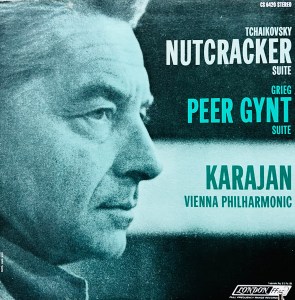The Music of Tchaikovsky Available Now
Album Reviews of the Music of Tchaikovsky

This import pressing has some astonishing qualities, qualities we are not used to hearing on vintage Golden Age recordings such as this (or or any other recordings, truth be told). This 1964 release — our pressing is the whiteback reissue, which we tend to prefer — has 3-D-like clarity and spaciousness that we could hardly believe. The stage is DEEP and you can hear all the way to the back of it. The width of the stage is dramatically wider than practically any record I can remember playing in the last year or two. I felt as though my listening room got bigger when playing this record.
And the dynamics are explosive. This pressing can really get LOUD when it wants to.
In some respects it’s hard to beat. But not, alas, hard to fault.
It lacks weight down low, whomp as we like to call it.
The details:
Side One
Amazing woodwinds right from the get go! So clear and airy. Quiet vinyl lets you hear into all the quiet parts of the music. A+ to A++ is the grade, due almost exclusively to the lack of bottom end. If you can add some bass this record would be killer.
Side Two
About the same. It can seem somewhat rich in places, but mostly it’s too thin, although big and wide as ever. A+
TRACK LISTING
Side One
Tchaikovsky – Nutcracker Suite
Side Two
Grieg – Music From Peer Gynt
The Nutcracker
The Nutcracker was Tchaikovsky’s last ballet. Working with a trite story in which there is no real human drama, Tchaikovsky was freed from having to worry about content, which allowed him to indulge his gift for memorable melody and ignited his imagination as an orchestrator. While the feeling of the ballet can at times seem rather shallow – a child’s Christmastime vision of the Kingdom of Sweets – the skill with which Tchaikovsky dresses up individual numbers in the most evocative orchestral colors still delights the ear.
Even where his melody is not extraordinary, Tchaikovsky’s treatment is. The main motive of the Act II pas de deux is nothing but a simple descending scale, yet the way it is harmonized and phrased, and clothed in the warmest of string colors, endows it with powerful sentiment. Tchaikovsky’s orchestration transcends the material in the overture as well; scored without cellos and basses, and with violins and violas divided into six parts, it conjures up the sound of a Classical orchestra with just a triangle and a piccolo added. A silvery, child-like, “play” overture, small in scale but full of glittering tinsel, it is just the thing for Christmas Eve.
The Nutcracker is typical of Tchaikovsky’s later music in its delicate use of the strings, which provide shimmering backdrops to many of the scenes. But it shows a literalism unusual for the composer, especially in the children’s voices in the “Waltz of the Snowflakes” and the children’s instruments for several other numbers in Act. I. The writing for standard instruments is marvelously inventive, particularly in the Act II divertissement, where chocolate is represented by a Spanish Dance, coffee by an Arabian Dance and tea by a Chinese Dance. But the most wonderful touch of all is the solo celesta in the “Dance of the Sugar-Plum Fairy,” which so charmingly suggests the drops of water “spurting from fountains” called for in the scenario.
From liner notes